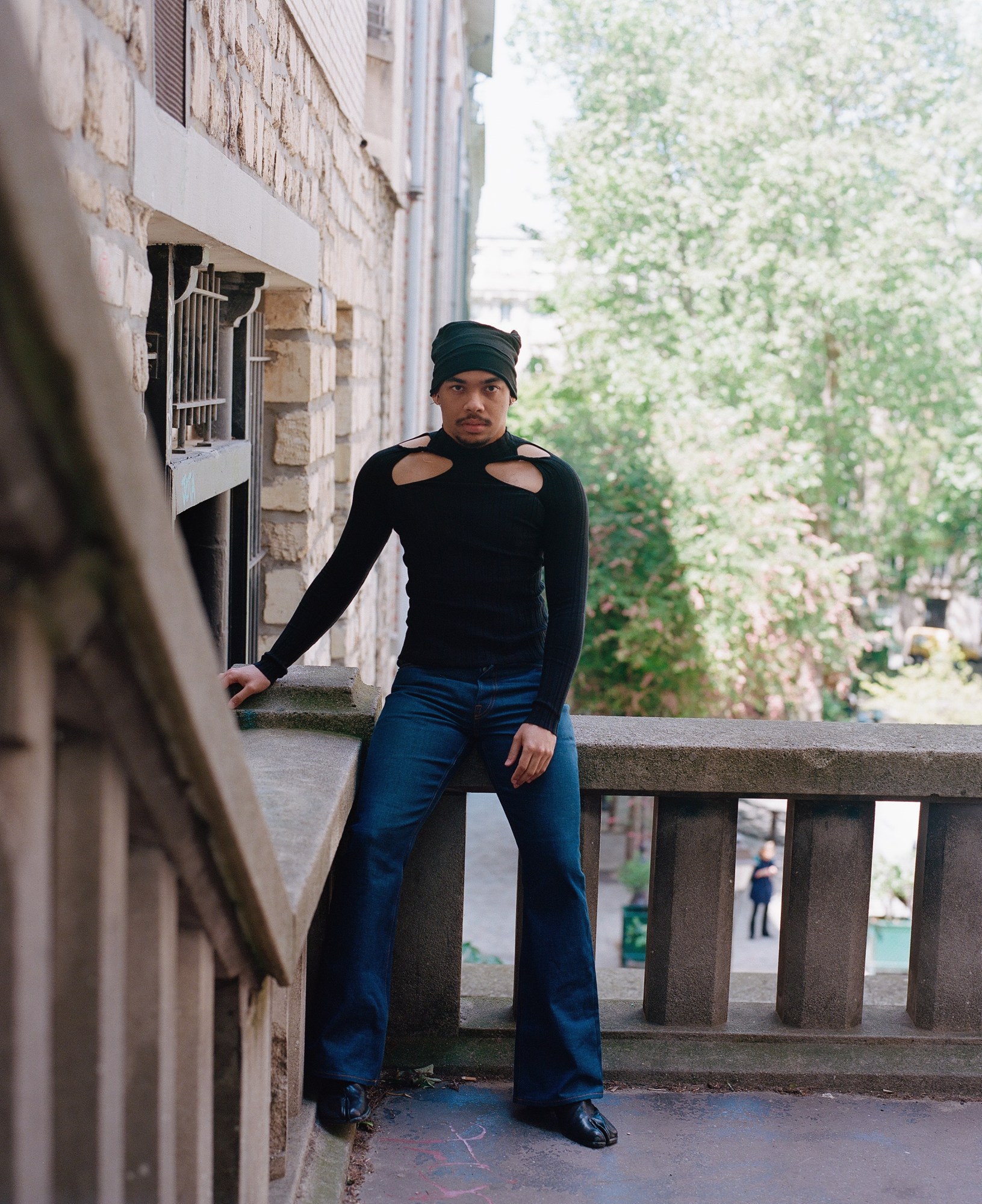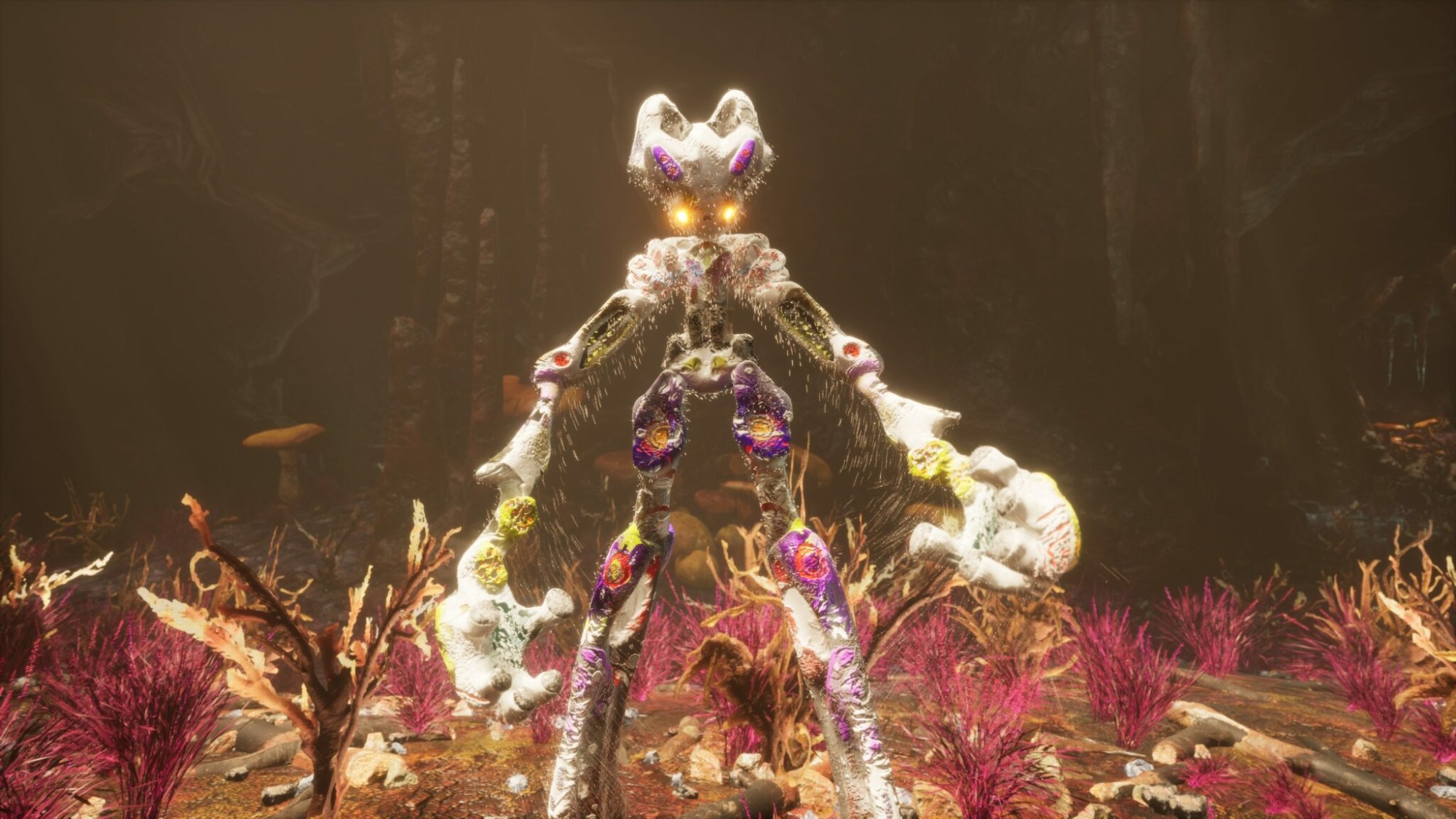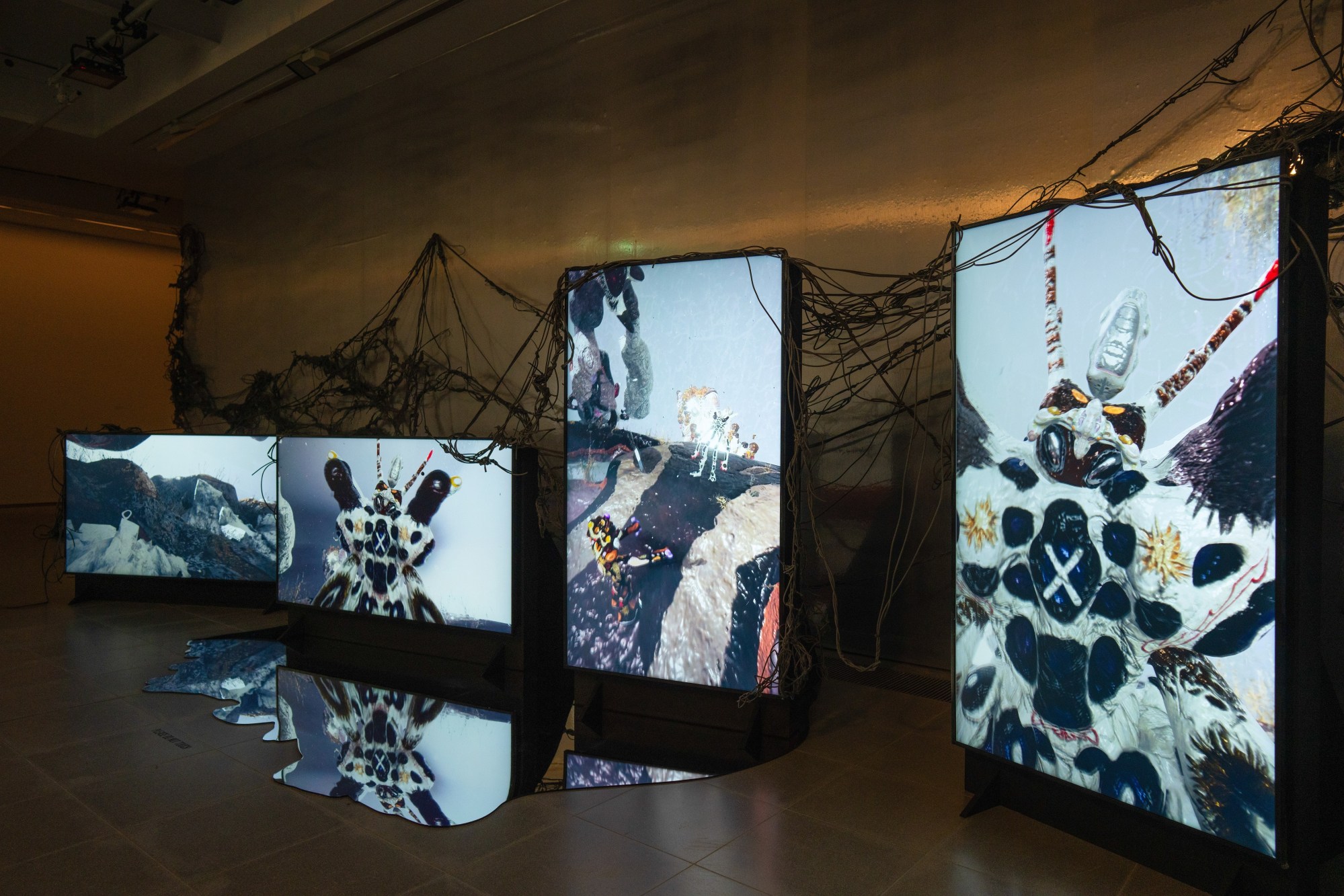Video game aesthetics are hardly new in fine art contexts, with artists such as Jon Rafman and Lawrence Lek, among many others, widely applauded for works that riff on and subvert the visual lexicons of familiar games. Actual playable video games, however? Well, that’s a different matter. Though no one is contesting the artistry involved in creating video games, their historically often stubbornly linear narratives – and frequent lack of engagement with the world beyond their digital confines – have typically seen them categorised as a form of entertainment, rather than as art. Of course, such boundaries are tenuous, and – with the global tally of gamers estimated at 3.75 billion – ready to be dismantled. Today, a generation of digital-native artists are doing just that, discovering in gaming a means to tap into new, more holistic, more powerful means of storytelling, and to merge the diverse streams of their practices.
At the forefront of this movement is Gabriel Massan, the Brazilian-born, Paris and Berlin-based multimedia artist. As part of Serpentine Arts Technologies – the Hyde Park institution’s pioneering exhibition programme that “proposes critical and interdisciplinary perspectives on advanced technologies […], challenging and reshaping the role that technologies can play in culture and society – they present Third World: The Bottom Dimension, an expansive playable universe created in collaboration with interdisciplinary artists Castiel Vitorino Brasileiro and Novíssimo Edgar, alongside sound artist and music producer LYZZA.
From spending their adolescence whiled away creating The Sims soap operas for a 60,000-strong YouTube audience to their time spent in an experimental noise band; their gig producing soundtracks for fashion shows to the immersive digital landscapes populated by the animated 3D sculptures they’re best known for today; the throughline of Gabriel’s multidimensional practice has always been an interest in the subversive potential of storytelling, and the desire to discover new means of bringing stories to life.

“Gaming offers a way to merge all my practices into a single medium,” the 26-year-old says over Zoom from their studio in Paris, where they’re currently completing a residency. “Fictional archaeology, this subversive otherness that I like to talk about, my understanding of ecology, my addiction to digital sculptures and personifying them to give them this organic feeling… On the other side, it’s a platform where I can really collaborate with multiple artists, designers and developers. And then there’s how it’s accessed by the public from different groups and locations, all for free. Games can serve as entertainment, they can live in galleries, and they merge digital art, digital sculpture, digital animation, AR, VR, NFTs… there are just so many possibilities.”
Rather than a fantastical reprieve from reality, the universe that Gabriel and their collaborators have fashioned in Third World: The Bottom Dimension is anchored in reality – or rather, in their particular experiences of it. A virtual ecosystem teeming with Gabriel’s animated sculptures, the game’s primary aim is to “simulate and narrate stories from the Black Brazilian experience”, a Serpentine release reads, “revealing rather than replicating systems of inequality” by encouraging players to move through a world in which linearity and an objective sense of ‘progression’ are denied. Shown at Serpentine North – one of the world’s most esteemed art institutions, located in one of the wealthiest areas of a city built on a foundation of imperial wealth – entering Third World: The Bottom Dimension immediately invites participants to contemplate the neo-colonial hierarchies implicit in Western conceptions of the so-called ‘third world’, and their individual complicity in upholding them.
Gabriel’s motivation for creating this environment is a product of their own lived experiences of structural inequity and violence, and their concerns for a future in which they remain intact. As a queer, Black person in Rio de Janeiro – first growing up in a city at the perimeter of its urban sprawl, and later receiving a scholarship to study at Parque Lage, Rio’s eminent art school located in the touristic Zona Sul – their experience of the city was explicitly coloured by marginality and exclusion. From navigating the racist expectations imposed on their work to having to navigate three-hour journeys to class with transit schedules designed to keep people from Rio’s predominantly Black peripheries from accessing the centre, Gabriel became increasingly aware that they were living in a city geared against them.

The 2018 murder of Matheusa Passarelli – a 21-year-old non-binary artist and activist, and a member of the Rio queer underground of which Gabriel was an active part – and routine searches at the hands of the racist police force that patrolled the area around Parque Lage were “key to me realising that I was trapped in a state consumed by a war on drugs, and that I was a target in it,” Gabriel sighs. “I knew that everything I did in Rio, and experienced in it, would be influenced by that, as this war influences how the city was designed, how it functions, and how you move through it.”
Coupled with a sense that the art they were creating at the time – predominantly experimental video works and physical performances – wasn’t fully understood in the Rio scene, Gabriel made the move to São Paulo, where they’d previously performed at the city’s art fair alongside Julliana Araújo to great acclaim. In 2019, an encounter with Igi Ayedun, an artist and founder of HOA, the first Black-owned gallery in Brazilian art history, precipitated a transatlantic hop to a residency in the south of Spain, followed by a move to Berlin.
Their arrival there, however, chimed with the onset of the pandemic, dramatically upending their experience of the city. “It was very heavy. When you move to a new country, the baseline is to try to make friends and build a community for yourself, but I wasn’t able to do that,” Gabriel says. As isolating as these circumstances were, though, they allowed them to “really turn inward and focus on my practice”, and consolidate their understanding of their work. They realised that the digital sculptures they’d been obsessively creating amounted to “an archive of memories, manifestations, symbols and signs that were taken from us… an attempt to build connections with our ancestral knowledge, and access it through my DNA.”

A yearning for a sense of community during isolation prompted a recognition of resonances among the sculptures, and their steps toward merging them in teeming, animated worlds. Fuelled by an interest in AR and VR, Gabriel set their sights on gaming design, a step facilitated by discussions with, and a subsequent commission from, the Serpentine Arts Technology team.
“In the beginning, I was really moved by the idea of creating an experience that not only criticised, but reflected on our ways of navigating and accessing different worlds and dimensions,” Gabriel reflects on the intentions behind Third World: The Bottom Dimension. “It wasn’t about occupying the game’s extraterrestrial dimension, but rather about how we as a society navigate and deal with ourselves and others within digital experiences.”
Whether accessed via the game’s open-access online platform or via custom gaming pods, players enter Third World as agents of the proto-colonial Headquarters, “a digital resource extraction company that offers journeys to digital worlds,” Gabriel explains. Tasked with collecting materials on the shadowy corporation’s behalf, you’re encouraged to document your progression by recording your actions, which are minted as Web3 tokens on the Tezos blockchain, allowing future players to discover the memories and actions of those who came before them as they go.
‘Progression’ in the game, however, is a loose notion. With its open horizons and intentionally dispersed storylines, players are free to explore and interact with the game’s geographies with full autonomy. You can choose, for example, to pursue the missions your set – and bear witness to the consequences of doing so – or to progress through Third World on your own terms. The main inhibiting factor, though, is energy. An exhaustible resource – not just for you, but for all living beings in the game’s environment – the consumption of energy crystals by one directly impacts access to sustenance for all. “They aren’t even replaced when you die,” Gabriel quips.
Third World’s decentralised gameplay experience is a consequence of its creative process. While Gabriel oversaw the overall narrative development and the creation of the game’s physical environment, its levels and soundscapes were left in the hands of their collaborators. The game’s first level, Igba Tingbo – developed by painter, academic and psychologist Castiel Vitorino Brasileiro – encourages players to contemplate themes of memory, healing and transmutation, “offering [them] experiences that make them look at themselves in order to find answers that the environment is looking for,” Gabriel explains. Through extensive, at times disorienting dialogues, Castiel “tests the player to see if there’s any sense of empathy, or if things are being noticed or not”.
Sòfo – the chapter conceptualised by rapper, poet and ‘multi-artist’ Novíssimo Edgar – broaches violence, desertification and ecological balance, entailing “a greater sense of confrontation and gentrification, demonstrating the consequences of a machine that has taken over the world,” Gabriel says. “This level is much more violent and destructive. It’s also based around ideas of pollution and desertification, so the inequality is much more stark.”

Responsible for the game’s expansive audio score and character voices – and by extension the nuanced moods of the myriad experiences within it – is producer and vocalist LYZZA, an artist “really drawn to imagery,” Gabriel notes. “She can deduce exactly what sort of sound something would make by looking at it – like, if I ask her for something that sounds dirty, but also like how a cellphone looks, she’ll create the exact sound I’m imagining.” While referential, her sounds are intentionally abstracted, “synthesised to become something that can’t be traced back to the sound of an object, instrument or movement. The more I do that, the more room that I create for people to move more freely within music or reach deeper to connect with unknown or undiscovered parts within themselves,” LYZZA says. “There’s nothing ‘real’, no ‘reality’ to hold onto. It was exciting for me to see how I could continue this thought process, but directly link them to objects in Gabriel’s world.”
This collective ethos spills beyond the game and into the exhibition space, where multimedia works by the game’s contributing artists – as well as by fellow Black Brazilian artists Jota Mombaça and Ventura Profana – are installed, exploring parallel themes of ancestral memory and decolonial thought. Beyond the artists, though, you are invited into the experience as an active participant, whether playing the game or not. Throughout the space, screens livestream gameplay, echoing the new ways in which video games are consumed today through channels like Twitch: inviting spectators to witness and, ultimately, judge the decisions made by players in real time. It’s a set-up that prompts reflections on notions of responsibility, complicity and agency in the face of the situations raised; on how, in a given context, you would act, and on whose behalf you’d be acting.
“Sometimes, we’re just living by missions that really aren’t ours, and a major objective of the game is to show that,” Gabriel says. “You enter it with a mission to complete, and then you’re asked onto another, and then another, but they aren’t linked. You’re invited to play with a sense of rebellion, and find your own path — but doing that could also result in your death. It then begs questions around whether you’d be willing to die for someone else’s mission; if you’d be OK with killing someone because you’re asked to. What sort of exchanges are you looking for inside the game, and what sort of challenges will you accept?”

“The game’s learning really depends on your efforts to play and understand Third World not only as a game, but as a philosophical, socio-economic and geographic issue,” Novíssimo concurs, underscoring the applicability of its lessons long after logging off. “It’s about realising that there are simultaneous attempts at colonisation installed in various devices in our reality, and in our desires; it’s about realising that our ‘gameplay’ in real life and our routines may well be directed by a divine entity or capitalist industry that interferes directly in our decisions; it’s about realising that the extraction of natural wealth across the planet can contribute to a universal and irreparable dystopia.”
Of course, these are messages that clearly emerge through a conscientious engagement with Third World. Their conviction, however, is less a consequence of an overtly didactic approach, and rather of the fact that players are ultimately tasked with arriving at these conclusions themselves. “The game really depends on your attention – the amount you pay to it will define how much you understand of it,” Gabriel says. The game perceives the player, but it also asks the player to perceive the game.”
It should be stressed that, its politically charged messages aside, Third World: The Bottom Dimension is an astounding technical achievement; a robust showcase of gaming’s potential to accessibly communicate the nuances of vital global conversations, and an exercise in showing how “fictional and critical storytelling can really help us tell the right stories, or retell stories,” as Gabriel puts it. It is, however, the uncompromising potency of its storyboard that gives the game its gravity and urgency – in particular, the throughline that binds its many narrative threads together. “The Western world evolves with warfare and the exploitation of other worlds,” Castiel says. “This game has the power to make people imagine other ways of relating to difference, to what is ‘strange’. I hope people think about how they imagine other cultures, other peoples, other worlds. I hope people reflect on themselves.”

Third World: The Bottom Dimension at Serpentine North until October 23rd 2023. Game also available to play here.

